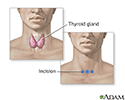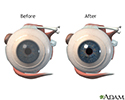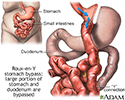Eardrum repair
Myringoplasty; Tympanoplasty; Ossiculoplasty; Ossicular reconstruction; Tympanosclerosis - surgery; Ossicular discontinuity - surgery; Ossicular fixation - surgeryEardrum repair refers to one or more surgical procedures that are done to correct a tear or other damage to the eardrum (tympanic membrane). Ossiculoplasty is the repair of the small bones in the middle ear.
The Basics
Tests for otolaryngology surgery
Self Care
Talking to your MD
Incision for thyroid gland surgery
The thyroid is a gland located in the neck. It is a part of the endocrine (hormone) system, and plays a major role in regulating the body's metabolism. If surgery or an open excisional biopsy is needed, an incision is made in front of the neck to gain access to the thyroid gland.
Incision for thyroid gland surgery
illustration
Before and after corneal surgery
Corneal surgery involves replacing the clear covering of the eye (cornea). The surgery is recommended for severe corneal infection, injury, scarring, and for corneas that no longer allow light to pass through. The outcome for corneal surgery is usually very good and transplanted corneas have a long life expectancy.
Before and after corneal surgery
illustration
Roux-en-Y stomach surgery for weight loss
The Roux-en-Y gastric bypass procedure involves creating a stomach pouch out of a small portion of the stomach and attaching it directly to the small intestine, bypassing a large part of the stomach and duodenum. Not only is the stomach pouch too small to hold large amounts of food, but by skipping the duodenum, fat absorption is substantially reduced.
Roux-en-Y stomach surgery for weight loss
illustration
Incision for thyroid gland surgery
The thyroid is a gland located in the neck. It is a part of the endocrine (hormone) system, and plays a major role in regulating the body's metabolism. If surgery or an open excisional biopsy is needed, an incision is made in front of the neck to gain access to the thyroid gland.
Incision for thyroid gland surgery
illustration
Before and after corneal surgery
Corneal surgery involves replacing the clear covering of the eye (cornea). The surgery is recommended for severe corneal infection, injury, scarring, and for corneas that no longer allow light to pass through. The outcome for corneal surgery is usually very good and transplanted corneas have a long life expectancy.
Before and after corneal surgery
illustration
Roux-en-Y stomach surgery for weight loss
The Roux-en-Y gastric bypass procedure involves creating a stomach pouch out of a small portion of the stomach and attaching it directly to the small intestine, bypassing a large part of the stomach and duodenum. Not only is the stomach pouch too small to hold large amounts of food, but by skipping the duodenum, fat absorption is substantially reduced.
Roux-en-Y stomach surgery for weight loss
illustration
Eardrum repair
Myringoplasty; Tympanoplasty; Ossiculoplasty; Ossicular reconstruction; Tympanosclerosis - surgery; Ossicular discontinuity - surgery; Ossicular fixation - surgeryEardrum repair refers to one or more surgical procedures that are done to correct a tear or other damage to the eardrum (tympanic membrane). Ossiculoplasty is the repair of the small bones in the middle ear.
The Basics
Tests for otolaryngology surgery
Self Care
Talking to your MD
Eardrum repair
Myringoplasty; Tympanoplasty; Ossiculoplasty; Ossicular reconstruction; Tympanosclerosis - surgery; Ossicular discontinuity - surgery; Ossicular fixation - surgeryEardrum repair refers to one or more surgical procedures that are done to correct a tear or other damage to the eardrum (tympanic membrane). Ossiculoplasty is the repair of the small bones in the middle ear.
The Basics
Tests for otolaryngology surgery
Self Care
Talking to your MD
Review Date: 5/30/2022
Reviewed By: Josef Shargorodsky, MD, MPH, Johns Hopkins University School of Medicine, Baltimore, MD. Also reviewed by David C. Dugdale, MD, Medical Director, Brenda Conaway, Editorial Director, and the A.D.A.M. Editorial team.


